Centauri Dreams
Imagining and Planning Interstellar Exploration
Falcon Heavy: Extraordinary!
The Tau Zero Foundation and Centauri Dreams congratulates team Space Exploration Technologies, for the successful, historic, pioneering test flight of the Falcon Heavy.
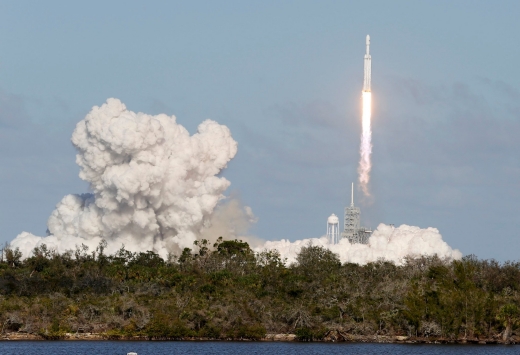
Ad Astra Incrementis indeed!
From all of us,
Jeff Greason
Marc Millis
Rhonda Stevenson
Andrew Aldrin
Paul Gilster
Bill Tauskey
Rod Pyle

Probing TRAPPIST-1 Planetary Atmospheres
This week offers two interesting papers about the TRAPPIST-1 planets, one from Hubble data looking at the question of hydrogen in potential planetary atmospheres, the other drawing on data from the European Southern Observatory’s Paranal facility as well as the Spitzer and Kepler space-based instruments. We’ll look at the Hubble work this morning and move on to the second paper tomorrow. Both offer meaty stuff to dig into, for we’re beginning to characterize these seven planets, which form a unique laboratory for the study of red dwarf systems.
Published in Nature Astronomy, the Hubble results screen four of the TRAPPIST-1 planets — d, e, f and g — to study their potential atmospheres in the infrared, using Hubble’s Wide Field Camera 3 in data collected from December 2016 to January 2017. The data allow us to rule out a cloud-free hydrogen-rich atmosphere on three of these worlds, while TRAPPIST-1g needs further observation before a hydrogen atmosphere can be conclusively excluded.
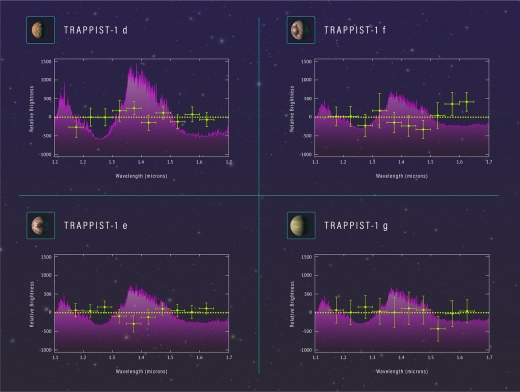
Image: These spectra show the chemical makeup of the atmospheres of four Earth-size planets orbiting within or near the habitable zone of the nearby star TRAPPIST-1. The habitable zone is a region at a distance from the star where liquid water, the key to life as we know it, could exist on the planets’ surfaces. To obtain the spectra, astronomers used the Hubble Space Telescope to collect light from TRAPPIST-1 that passed through the exoplanets’ atmospheres as the alien worlds crossed the face of the star. Credit: NASA, ESA, and Z. Levy (STScI).
Pay particular attention to the purple curves in the above image. These show the signature we would expect to see from gases like water and methane, which would be found if any of these planets had a hydrogen-dominated atmosphere like Neptune’s. The spectroscopic signature should be strong in the near-infrared. The Hubble results are indicated by the green crosses, clearly showing no evidence of such an extended atmosphere for TRAPPIST-1 d, f and e.
Julien de Wit (Massachusetts Institute of Technology), lead author on the paper, explains the significance of the finding:
“The presence of puffy, hydrogen-dominated atmospheres would have indicated that these planets are more likely gaseous worlds like Neptune. The lack of hydrogen in their atmospheres further supports theories about the planets being terrestrial in nature. This discovery is an important step towards determining if the planets might harbour liquid water on their surfaces, which could enable them to support living organisms.”
The work proceeded through transmission spectroscopy, in which some of the light of the star passes through the planetary atmosphere and leaves a distinctive trace in the star’s spectrum. The beauty of the TRAPPIST-1 system is that we have so many transits to work with. Moreover, all seven of the planets orbit their star much closer than Mercury is to the Sun, so we have transits occurring frequently, and the possibility of liquid water on some planetary surfaces. We’re also dealing with a planetary system that’s a relatively nearby 40 light years away.
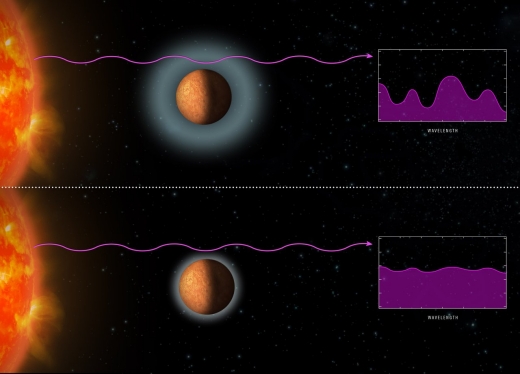
Image: The graphic at the top shows a model spectrum containing the signatures of gases that the astronomers would expect to see if the exoplanets’ atmospheres were puffy and dominated by primordial hydrogen from the distant worlds’ formation. The Hubble observations, however, revealed that the planets do not have hydrogen-dominated atmospheres. The flatter spectrum shown in the lower illustration indicates that Hubble did not spot any traces of water or methane, which are abundant in hydrogen-rich atmospheres. The researchers concluded that the atmospheres are composed of heavier elements residing at much lower altitudes than could be measured by the Hubble observations. Credit: NASA, ESA and Z. Levy (STScI).
If heavier gases like carbon dioxide, methane, water and oxygen are atmospheric constituents in this system, the James Webb Space Telescope may well be able to find them. What the Hubble work achieves is to take one possibility off the table before JWST goes to work, assuming the latter is successfully deployed in 2019.
The TRAPPIST-1 planets may have had hydrogen atmospheres when first formed, assuming they formed further away from the parent star and migrated into their present positions. The primordial hydrogen would then have been lost as the planets moved close to the star, allowing the formation of secondary atmospheres. Our own Solar System’s rocky planets evidently formed in hotter and drier regions much closer, on a relative basis, to the Sun.
Hannah Wakeford (STScI), one of the scientists involved with this work, adds:
“There are no analogs in our solar system for these planets. One of the things researchers are finding is that many of the more common exoplanets don’t have analogs in our solar system.”
The paper is de Wit et al., “Atmospheric reconnaissance of the habitable-zone Earth-sized planets orbiting TRAPPIST-1,” Nature Astronomy 5 February 2018 (abstract). Tomorrow we’ll look at work just published in Astronomy and Astrophysics on new constraints on the mass, density and composition of the seven planets around TRAPPIST-1.

Detection of Extragalactic Planets?
I was pleased to be a guest on David Livingston’s The Space Show last week. David’s questions are always well chosen, as were those of the listeners who participated in the show, and we spoke broadly about the interstellar effort and what it will take to eventually get human technologies to the stars. The show is now available in David’s archives.
I suspect that if David and I had spoken a couple of days later, the topic would have gotten around to gravitational microlensing, and specifically, the news about planets in other galaxies. On the surface, the story seems sensational. In our own galaxy, we can use radial velocity and transit studies on stars, but here our working distances are constrained by our method. The original Kepler field of view in Cygnus, Lyra and Draco, for example, contained stars ranging from 600 to 3000 light years out — get beyond 3000 light years and transits are not detectable.
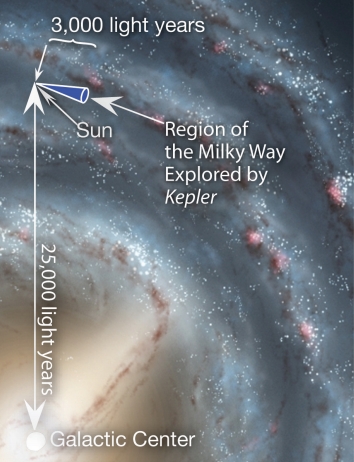
Image: The Sun is about 25,000 light years from the center of the galaxy, about half the distance from the center to the edge. The blue cone shows the region of the Milky Way that Kepler explored for planets. Kepler looked along a spiral arm of our galaxy. The distance to most of the stars for which Earth-size planets can be detected by Kepler is from 600 to 3,000 light years. Less than 1% of these stars in the region are closer than 600 light years. Stars farther than 3,000 light years are too faint for Kepler to observe the transits needed to detect Earth-size planets. Credit: NASA/JPL-Caltech/R. Hurt (SSC).
Gravitational microlensing, in which a star moves in front of a more distant star so that light from the background object is distorted by the foreground star’s gravitational field, can turn up distant planets within our own galaxy. In fact, it’s quite a useful tool because it is not limited by line of sight — no planet needs to transit — and is not dependent on the planet’s distance from its star.
Microlensing has allowed us to find planets thousands of light years away, near the center of the Milky Way. We see the pattern of the microlensing event temporarily disrupted by a spike of brightness as the planet around the closer star causes its own gravitational disruption.
But how do we hope to find planets billions of light years away? At the University of Oklahoma, Xinyu Dai and Eduardo Guerras have tackled the question using data from the Chandra X-Ray Observatory, working with microlensing models calculated at the university’s Supercomputing Center for Education and Research. Their work revolved around the microlensing properties of a supermassive black hole at the center of quasar RX J1131-1231. The background quasar, about 6 billion light years away, is what is being lensed by the foreground galaxy, which is 3.8 billion light years out.
We are dealing with what is known as a quasar-galaxy strong lensing system, one in which a background quasar is being gravitationally lensed by a foreground galaxy. The result is that multiple images of the quasar form, as seen in the image below. The light from the background quasar crosses different locations in the foreground galaxy, and is lensed as well by nearby stars in the lens galaxy, an effect called quasar microlensing. The latter is a useful tool, for astronomers have used it to study accretion disks around supermassive black holes at the center of quasars. It can also provide information about the lensing galaxy itself.
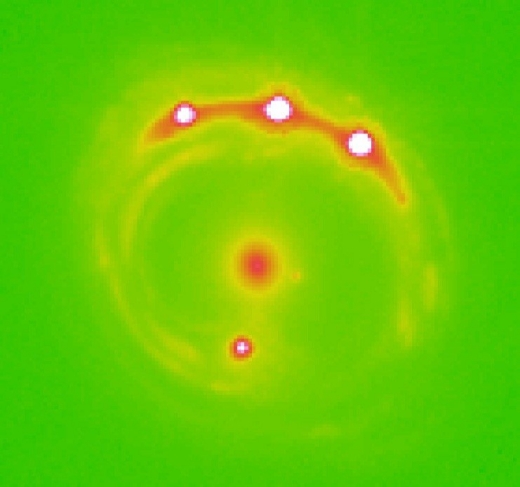
Image: The gravitational lens RX J1131-1231 galaxy with the lens galaxy at the center and four lensed background quasar images. Credit: University of Oklahoma.
Let’s turn to the paper, where the relevance of this to extragalactic planets emerges:
As we probe smaller and smaller emission regions of the accretion disk close to the event horizon of the SMBH, the gravitational fields of planets in the lensing galaxy start to contribute to the overall gravitational lensing effect, providing us with an opportunity to probe planets in extragalactic galaxies…
The authors analyze the Einstein ring created by lensing effects to show that emissions close to the Schwarzschild radius of the central supermassive black hole of the source quasar will be affected by planets in the lensing galaxy. Thus we have a way of identifying a population of planets in another galaxy, though not planets orbiting a central star. For the paper goes on:
We have shown that quasar microlensing can probe planets, especially the unbound ones, in extragalactic galaxies, by studying the microlensing behavior of emission very close to the inner most stable circular orbit of the super-massive black hole of the source quasar. For bound planets, they contribute little to the overall magnification pattern in this study.
These planets would be, in other words, so-called ‘rogue’ planets not associated with any star, for bound planets of the kind we are used to studying with radial velocity and transit methods would be below the threshold of detection — they would not change the magnification patterns being observed.
The numbers on these rogue planets are impressive: Roughly 2000 objects per main sequence star in sizes ranging between the Moon and Jupiter — 200 of these per main sequence star would be in the Mars to Jupiter range.
These numbers, Dai and Guerras note, are consistent with theoretical studies showing a large population of unbound planets in our own galaxy. Stanford’s Louis Strigari and colleagues, for example, have found that there may be up to 105 compact objects per main sequence star in the Milky Way, using evidence from microlensing as well as direct imaging. Our galaxy may, in other words, be well populated with such objects, most of these relatively small but some larger than Jupiter. See Island Hopping to the Stars for more on Strigari’s work.
What to make of all this? Before this work, the only evidence for an extragalactic planet was the microlensing event PA-99-N2, detected in 1999, and consistent with a star in the disk of M31, the Andromeda galaxy, lensing a background red giant. A planet of 6 times Jupiter’s mass is one explanation for the lensing profile, but there is no way to confirm the possible planet.
Now we have not the detection of individual planets but a hypothesis that lensing data of a galaxy 3.8 billion light years away can be explained by the presence of a population of unbound planets and other compact objects much smaller than planets. The idea that there would be planets in other galaxies is hardly unusual, given their numbers in our own Milky Way. But it’s an exciting thought that we can now begin to study extragalactic exoplanets, even if we’re extremely early in the process and there is much to be learned. As the paper notes:
It is possible that a population of distant but bound planets (Sumi et al. 2011) can contribute to a significant fraction of the planet population, which we defer to future investigations. Because of the much larger Einstein ring size for extragalactic microlensing, we expect that two models, the unbound and the distant but bound planets, can be better distinguished in the extragalactic regime.
The paper is Xinyu Dai & Eduardo Guerras, “Probing Planets in Extragalactic Galaxies Using Quasar Microlensing,” accepted at Astrophysical Journal Letters (preprint). And if you’re interested in the PA-99-N2 event, one source is Ingrosso et al., “Detection of Exoplanets in M31 with Pixel-Lensing: The Event Pa-99-N2 Case,” Twelfth Marcel Grossmann Meeting: on Recent Developments in Theoretical and Experimental General Relativity. p. 2191 (preprint).

Gravitational Lensing: Untangling an Image
The behavior of distant galaxies may tell us much about our own Milky Way’s evolution, as well as alerting us to the differing outcomes possible as galaxies mature. This morning we look at a galaxy labeled eMACSJ1341-QG-1, one that puts on display the phenomenon of gravitational lensing. We may one day use the distortion of spacetime caused by massive objects much closer to home to study nearby stars and their planets, assuming we can learn to exploit the natural gravitational lensing effect that occurs at 550 AU from the Sun.
But back to the galactic perspective. Lined up with a massive galaxy cluster called eMACSJ1341.9-2441, the light from the much more distant galaxy is magnified by 30 times as the gravity of the intervening cluster — its presumed dark matter, gas and thousands of individual galaxies — distorts spacetime. Gravitational lensing was confirmed during a solar eclipse in 1919, when background stars were found to be offset in precisely the way Albert Einstein had predicted. Astronomers now rely on such lensing to produce information about objects that would otherwise be all but invisible.

Image: The quiescent galaxy eMACSJ1341-QG-1 as seen by the Hubble Space Telescope. The yellow dotted line traces the boundaries of the galaxy’s gravitationally lensed image. The inset on the upper left shows what eMACSJ1341-QG-1 would look like if we observed it directly, without the cluster lens. The dramatic amplification and distortion caused by the intervening, massive galaxy cluster (of which only a few galaxies are seen in this zoomed-in view) is apparent. Credit: Harald Ebeling, UH IfA.
Discovery of the quiescent galaxy, identified as a gravitationally lensed triple image, was confirmed by the ESO/X-Shooter spectrograph, mounted at the European Southern Observatory’s Very Large Telescope site at Cerro Paranal in Chile. Harald Ebeling (University of Hawaii, Honolulu), lead author of the paper on this work, describes the effort, which has now produced a new record for magnification of this type of galaxy:
“We specialize in finding extremely massive clusters that act as natural telescopes and have already discovered many exciting cases of gravitational lensing. This discovery stands out though, as the huge magnification provided by eMACSJ1341 allows us to study in detail a very rare type of galaxy.”
Quiescent galaxies — those in which star formation has all but ceased — represent the endpoint of galaxy evolution, which makes this one somewhat unusual. Objects at this redshift should be young enough not to have used up their gas supply. Hence learning why eMACSJ1341-QG-1 has stopped forming stars is a significant quest.
Working with data from the Hubble Space Telescope, Ebeling and colleagues now continue the study through HST imaging as well as ground-based instruments, and further analysis of the lens model that allows them to remove distortion from the magnified image. From the paper;
Although ground-based spectroscopy with facilities in Chile and on Maunakea will allow the characterization of the stellar populations of eMACSJ1341-QG-1, an analysis of its spatial profile and any radial dependencies of its properties relies on the availability of resolved colors and a robust lens model that allows the reconstruction of the galaxy in the source plane. HST imaging in multiple filters will be critically important to achieve either of these goals.
There is much to learn:
While it is widely accepted that already at z?1.5 a majority of the most massive galaxies had evolved stellar populations and form few stars, the observational evidence behind this picture is not conclusive, in particular regarding the puzzlingly compact size of some of these galaxies, the quenching mechanism, and the impact of dust on the apparent prominence of the old stellar population.
Centauri Dreams’ take: Fascinating in its own right, gravitational lensing studies like these remind us that when we do become capable of sending spacecraft to 550 AU and beyond to explore the uses of the Sun’s lens to study possible mission targets, we’re faced with huge questions of how to remove the massive distortion of the image, untangling it to produce workable information. The rapidly advancing field of deep-sky gravitational lensing should produce numerous insights into how we approach lensed images from future space missions.
Let me also note this: Gravitational focus lensing in the context of space missions was discussed by Geoff Landis (NASA GRC) as well as Slava Turyshev (JPL) at the most recent Tennessee Valley Interstellar Workshop. You can see the video of both presentations here.
The paper is Ebeling et al., “Thirty-fold: Extreme Gravitational Lensing of a Quiescent Galaxy at z = 1.6,” Astrophysical Journal Letters Vol. 852, No. 1 (abstract / preprint).

Lupus 3: Into the Dust
An absorption nebula, or ‘dark’ nebula, is a dense cloud of interstellar dust that can block the visible light from objects within or behind it. Today’s image shows a striking cloud in the star-forming region Lupus 3, a dazzling view that simply demanded placement on Centauri Dreams. If you’re looking for an interstellar flight angle, think about the issue of shielding a relativistic starship in regions so dense with gas and dust, zones that can stretch for hundreds of light years. But I need no other angle here — the image is majestic in and of itself.
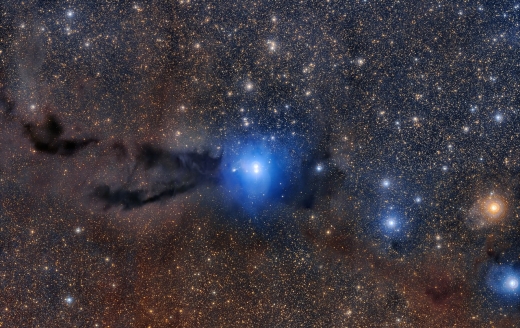
Image: A dark cloud of cosmic dust snakes across this spectacular wide field image, illuminated by the brilliant light of new stars. This dense cloud is a star-forming region called Lupus 3, where dazzlingly hot stars are born from collapsing masses of gas and dust. This image was created from images taken using the VLT Survey Telescope and the MPG/ESO 2.2-metre telescope and is the most detailed image taken so far of this region. Credit: ESO/R. Colombari.
Lupus 3 is found in Scorpius, about 600 light years from Earth, part of the larger complex called the Lupus Clouds. The cold dust absorbs and scatters light as it passes through the cloud, making objects within them viewable only in radio or infrared wavelengths. Frozen carbon monoxide and nitrogen are primary components blocking visible light, but molecular hydrogen, helium and a variety of more transparent ingredients are found within. Some of these absorption nebulae are familiar, great black swathes against background stars, like the Coalsack Nebula.
Lupus 3 is rich in T Tauri stars, variables that are pre-main-sequence stars in the process of contracting. These are young objects that have not yet begun hydrogen fusion at the core but are still powered by gravitational energy as their contraction takes them toward the main sequence. Note the two bright stars in the center of the above image. Growing hotter and brighter, their radiation and stellar winds would have swept out nearby gas and dust, allowing their emergence at visible wavelengths. Our Sun may have formed in a region much like this.
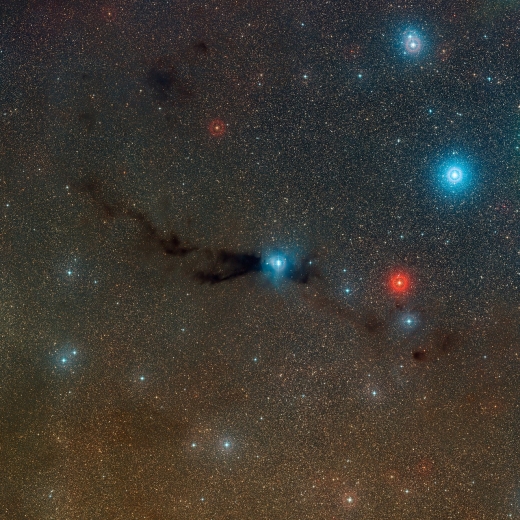
Image: This wide-field view shows Lupus 3, where new stars are forming along with clusters of brilliant stars that have already burst out of their dusty stellar nursery. It is likely that the Sun formed in a similar star formation region more than four billion years ago. This view was created from images forming part of the Digitized Sky Survey 2. Credit: ESO/Digitized Sky Survey 2. Acknowledgement: Davide De Martin.
Shielding a Starship
Let’s get back to interstellar flight issues for a moment. So much depends on where we are traveling when we think about dust mitigation. When the Daedalus designers worked on the first full specifications for a starship back in the 1970s, they included a payload shield some 32-meters in radius. Future starships moving at a high fraction of c would obviously do well to avoid dense nebulae, but we also have to think about shielding fast flyby probes as they enter destination systems, where gas and dust levels can reach dangerous levels.
The Daedalus beryllium shield was one option, and Gregory Matloff has suggested that a forward-firing laser could also be deployed to deflect larger particles along the route. The issue could be significant: Dana Andrews (Andrews Space) has calculated that for a starship moving at 0.3 c, a tenth of a micron grain of typical carbonaceous dust would have a relative kinetic energy of 37,500,000 GeV. We have much to learn about the true size distribution of dust particles in the nearby interstellar medium before embarking on interstellar missions, which is Bruce Draine, author of the definitive Physics of the Interstellar and Intergalactic Medium, is serving as a consultant with the Breakthrough Starshot effort.
For more on star formation in regions like this, see Comerón, “The Lupus Clouds,” in Handbook of Star Forming Regions Vol. II, Astronomical Society of the Pacific (2008), available here in full text. Dana Andrews’ paper is Andrews, “Things to Do While Coasting Through Interstellar Space,” AIAA-2004-3706, 40th AIAA/ASME/SAE/ASEE Joint Propulsion Conference and Exhibit, Fort Lauderdale, Florida, July 11-14, 2004.

Organic Molecules in the Magellanics
If for some reason I had to come up with a different name for Centauri Dreams, I think it might just be Magellanic Dreams. I say this because, like the Alpha Centauri stars themselves, the Magellanics have been something of an obsession since my childhood. Dwarf galaxies orbiting the Milky Way, the Large and Small Magellanic Clouds took my imagination outside our galaxy to a place where it could be viewed in all its splendor (or maybe not: See The Milky Way from Outside for why galaxy viewing can be problematic).
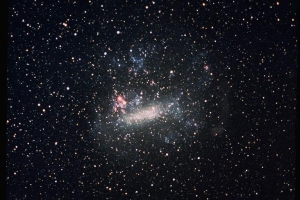
The Large Magellanic Cloud is 160,000 light years away (contrast this with M-31’s 2.5 million light years), while the SMC is about 200,000 light years out. Science fiction brought us Olaf Stapledon’s telepathic aliens living in the LMC — these guys were made to order for the emerging field of Dysonian SETI in that they did engineering on a planetary scale (see Star Maker for more). And remember where the spacecraft in Arthur C. Clarke’s Rendezvous with Rama was heading at the end? It appeared to have used its solar assist to set course for the LMC.
Image: The Large Magellanic Cloud and Supernova 1987A taken by the Kuiper Airborne Observatory (NASA 714) during its New Zealand deployment in 1987. Credit: NASA.
There are too many science fiction references to the Large and Small Magellanics to get into today, from Heinlein’s Have Space Suit Will Travel to Iain Banks’ The Player of Games. I’m now trying to curb my SF enthusiasm (but do read Silverberg’s Collision Course some time to get the backward view of the Milky Way from the LMC). Because what triggered all these thoughts is new work out of the National Radio Astronomy Observatory on the subject of unusual findings in the Large Magellanic Cloud.
Here we’re dealing with data from the Atacama Large Millimeter/submillimeter Array (ALMA). Astronomer Marta Sewi?o (NASA GSFC) and colleagues have found clear evidence of complex organic molecules in the Large Magellanic Cloud, including methanol, dimethyl ether, and methyl formate. The finding raises the eyebrows just a bit because the LMC is nowhere near as rich in heavy elements like carbon, nitrogen and oxygen as our Milky Way — in astronomical terms, these dwarf galaxies exhibit low metallicity. While methanol has been studied in the LMC before, the dimethyl ether and methyl formate are new findings.
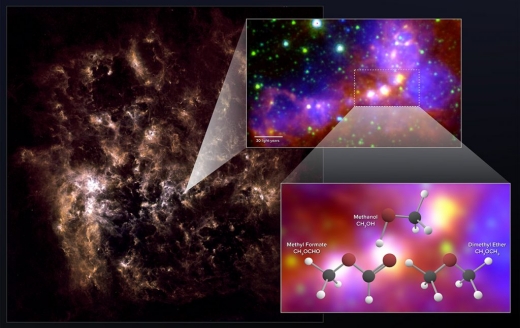
Image: Astronomers using ALMA have uncovered chemical “fingerprints” of methanol, dimethyl ether, and methyl formate in the Large Magellanic Cloud. The latter two molecules are the largest organic molecules ever conclusively detected outside the Milky Way. The far-infrared image on the left shows the full galaxy. The zoom-in image shows the star-forming region observed by ALMA. It is a combination of mid-infrared data from Spitzer and visible (H-alpha) data from the Blanco 4-meter telescope. Credit: NRAO/AUI/NSF; ALMA (ESO/NAOJ/NRAO); Herschel/ESA; NASA/JPL-Caltech; NOAO.
Focusing on two star-forming ‘embryos’ in the LMC (also known as ‘hot cores’), the astronomers think they’re gaining insights into the formation of complex organic molecules in the early universe. That’s because dwarf galaxies with relatively low masses produce a slower rate of star formation, so the LMC may well be chemically similar to distant, younger galaxies. Seeding a galaxy with heavy elements takes generations of star formation and evolution. Says Sewi?o:
“Even though the Large Magellanic Cloud is one of our nearest galactic companions, we expect it should share some uncanny chemical similarity with distant, young galaxies from the early universe… Young, primordial galaxies simply didn’t have enough time to become so chemically enriched. Dwarf galaxies like the LMC probably retained this same youthful makeup because of their relatively low masses, which severely throttles back the pace of star formation.”
The LMC’s N113 Star Formation Region is massive and rich in gas, with a large number of protostars that throw a bright infrared signature. Several of these young stellar objects have produced the spectral evidence for dimethyl ether and methyl formate. The latter two have never been detected at such a distance from Earth, while methanol, a relatively simple compound, is significant because it is essential for the formation of the more complex organic molecules.
Tying these findings to implications for the early universe, the researchers note that the presence of complex organic molecules — molecules containing six or more atoms including carbon — around protostars indicates they would likely be incorporated in emerging protoplanetary disks. Indeed, such molecules may well have been delivered to the young Earth by comets and meteorites. And if chemically primitive regions like the LMC can produce them, then we have the possibility that life could have taken hold early in the history of the cosmos, as these are the building blocks of molecules that are essential to its emergence.
The paper is Sewi?o et al., “The Detection of Hot Cores and Complex Organic Molecules in the Large Magellanic Cloud,” Astrophysical Journal Letters Vol. 853, No. 2 (30 January 2018). Abstract.


